 PERFECTION / SPECULATION in conversation with Natasha Vita-More at Vigelandmuseet, Oslo
PERFECTION / SPECULATION in conversation with Natasha Vita-More at Vigelandmuseet, OsloPhoto Katharina Gellein Viken & Charles Kriel
Adam Peacock is a research-led artist, educator, and strategic consultant whose work examines how digital infrastructures shape identity, desire, and behaviour within contemporary culture. Working across art, design, and applied research contexts, his practice interrogates the ways algorithmic systems, platform economies, and optimisation logics increasingly mediate how individuals understand themselves and others in an increasingly complex world.
THE VALIDATION JUNKY — Conceptual Research Framework
THE VALIDATION JUNKY is at the heart of Adam’s practice and operates as an ongoing conceptual research framework that explores the cultural and psychological consequences of algorithmic validation through designed experiments. Developed since 2014, the project investigates how online identity becomes a marketable asset, and how expressions of self are shaped, steered, and normalised within AI-integrated systems. The framework operates across drawing, installation, speculative design, and public research programmes, and forms the conceptual foundation of his doctoral research in Visual Cultures at Goldsmiths, University of London, supported by the UK Economic and Social Research Council and the South East Network for Social Sciences.
Adam’s work sits at the intersection of critical design, systems thinking, and cultural analysis. Adam’s background in architecture from The Bartlett School of Architecture, UCL, and postgraduate study at the Royal College of Art inform his practice, where identity is explored as an infrastructural condition rather than a personal or aesthetic consideration. Adam develops frameworks that reveal how technological systems embed values, biases, and expectations into everyday life across exhibitions, teaching, and consultancy.
IDENTITY MECHANISMS — Applied Systems Practice
Alongside experimental artistic practice, Adam is the founding director of IDENTITY MECHANISMS (ID-M), a research-driven consultancy that translates critical and speculative inquiry into applied strategy for commercial, cultural, and institutional contexts. Through ID-M, Adam works with organisations operating across fashion, product design, automotive, architecture, and digital platforms, supporting them in understanding how identity, aspiration, and value are constructed within algorithmically mediated environments. His role within these projects focuses on early-stage research, sense-making, and the development of insight-led frameworks and future scenarios that align emerging technologies with ethical, cultural, and human considerations.
Adam’s work moves fluidly between gallery, academic, and applied settings. He has exhibited and presented work internationally, and his research has been disseminated through invited lectures, teaching, public programmes, and interdisciplinary panels exploring AI, identity, and contemporary culture. His teaching practice reflects the same research concerns, emphasising speculative methods, critical engagement with technology, and the development of student-led agency within complex socio-technical systems.
Before establishing ID-M, Adam held senior design roles at Heatherwick Studio, WilkinsonEyre, and Amanda Levete Architects, contributing to major international architectural and urban projects across Europe, Asia, and North America. Adam’s ongoing research continues to explore the shifting boundaries between technology, culture, and subjectivity, with projects that anticipate and interrogate emergent modes of identity in an algorithmic era.
Alongside experimental artistic practice, Adam is the founding director of IDENTITY MECHANISMS (ID-M), a research-driven consultancy that translates critical and speculative inquiry into applied strategy for commercial, cultural, and institutional contexts. Through ID-M, Adam works with organisations operating across fashion, product design, automotive, architecture, and digital platforms, supporting them in understanding how identity, aspiration, and value are constructed within algorithmically mediated environments. His role within these projects focuses on early-stage research, sense-making, and the development of insight-led frameworks and future scenarios that align emerging technologies with ethical, cultural, and human considerations.
Adam’s work moves fluidly between gallery, academic, and applied settings. He has exhibited and presented work internationally, and his research has been disseminated through invited lectures, teaching, public programmes, and interdisciplinary panels exploring AI, identity, and contemporary culture. His teaching practice reflects the same research concerns, emphasising speculative methods, critical engagement with technology, and the development of student-led agency within complex socio-technical systems.
Before establishing ID-M, Adam held senior design roles at Heatherwick Studio, WilkinsonEyre, and Amanda Levete Architects, contributing to major international architectural and urban projects across Europe, Asia, and North America. Adam’s ongoing research continues to explore the shifting boundaries between technology, culture, and subjectivity, with projects that anticipate and interrogate emergent modes of identity in an algorithmic era.

 THE VALIDATION JUNKY at RAM Gallery, Oslo
THE VALIDATION JUNKY at RAM Gallery, Oslo